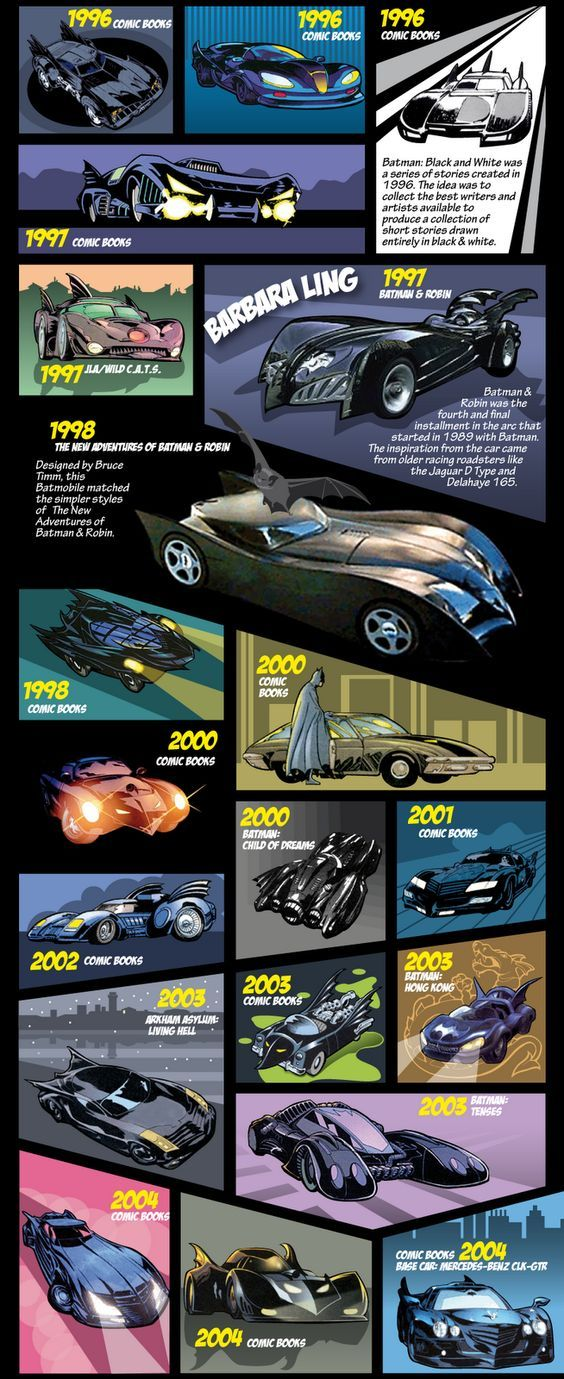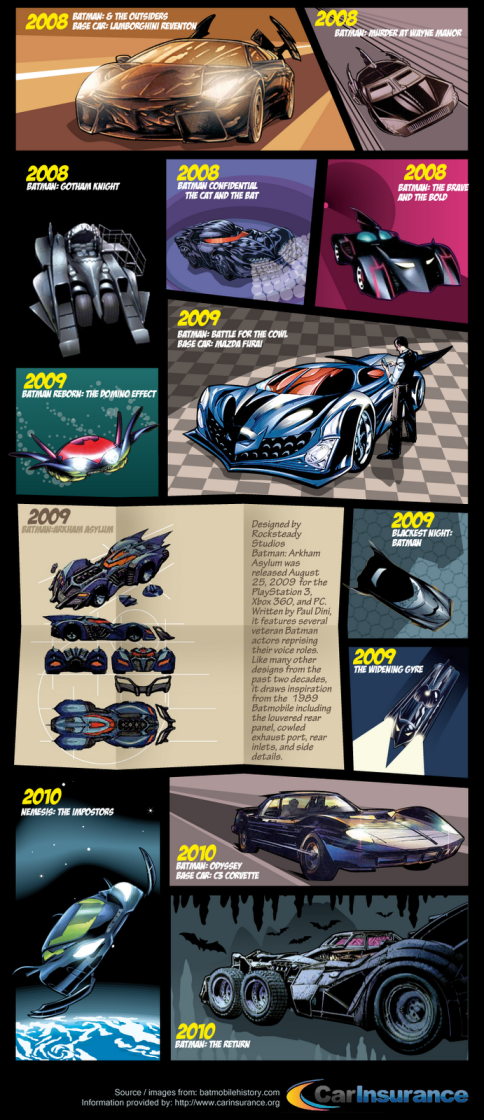The Complete History of the Batmobile: Every Version from Comics to Film (1939 - Present)
- Story Cars
- Nov 3, 2024
- 6 min read

The Batmobile has evolved significantly since its inception, becoming one of the most iconic vehicles in popular culture. Featured in various forms of media, including comics, television shows, movies, and video games, the Batmobile is not just a mode of transportation for Batman but a character in its own right. This article explores every version of the Batmobile, detailing its design, features, and the context within which it appeared.
The Original Batmobile: Detective Comics # 27 (1939)


Batman made his debut in Detective Comics # 27 in 1939, but he did not yet have a specific vehicle associated with him. Instead, he drove a series of nondescript sports cars. The term "Batmobile" would not be coined until 1941, when it first appeared in Batman # 5. The early design was a red hotrod resembling a Cord 812, equipped with a supercharged V8 engine. It laid the groundwork for what would become one of the most recognizable vehicles in comic history.
The Black & White Serials (1943/1949)


In the low-budget black and white Batman serials from the 1940s, the characters did not have a dedicated Batmobile. Instead, they drove Bruce Wayne's personal vehicles, such as a 1939 Cadillac Series 75 convertible and a 1949 Ford Mercury convertible. These serials were characterized by their simplistic storytelling and costumes, lacking the sophistication and style that would come with future adaptations.
The "Bat-tering Ram" (1940s and 50s)


During the 1940s and 50s, Batman's vehicle underwent a significant transformation thanks to artist Jerry Robinson. In Batman # 20 (1943), he redesigned the Batmobile to incorporate a sleek, gothic look, complete with a large bat-shaped hood ornament that served as a battering ram. This design became synonymous with the character and set a precedent for future iterations of the Batmobile.
Batman '66: The Campy Classic

The 1966 television series starring Adam West introduced a new, stylish Batmobile that became emblematic of the character for decades. Designed by George Barris and based on the 1955 Lincoln Futura concept car, this Batmobile was a glossy black with red accents and packed with gadgets. It featured a variety of tools, such as a Bat-radar, Bat-scope, and even a "batzooka." This iteration captured the campy spirit of the show and is still celebrated for its design and flair.
1960s Influence: Toys and Cartoons

Following the success of the 1966 series, the Batmobile's design continued to evolve in comics and animated series, often drawing inspiration from the West-mobile. The 70s introduced a sleeker, darker Batmobile as comics returned to their more serious roots, with a blue and yellow color scheme becoming prevalent in various adaptations.
Frank Miller's "The Dark Knight Returns" (1986)

In Frank Miller's groundbreaking graphic novel The Dark Knight Returns, the Batmobile was reimagined as a heavily armored vehicle built for combat, often referred to as the "bat-tank." This vehicle was less about stealth and more about brute force, reflecting the darker tone of the narrative. It became a key component of Batman's arsenal in a gritty and dystopian Gotham City.
Tim Burton's Batmobile: The Iconic '89 Model

Tim Burton's Batman (1989) presented one of the most visually stunning interpretations of the Batmobile. Designed by Anton Furst, this version was built on a Chevrolet Impala chassis, featuring a long, sleek silhouette and an intimidating design inspired by Gothic architecture. The Batmobile was equipped with an array of gadgets, including voice activation and remote control, and could accelerate from 0 to 60 mph in just 3.7 seconds. Its portrayal in the film, especially during the iconic reveal scene, cemented its place in cinematic history.
Batman: The Animated Series (1992)

The Batmobile in Batman: The Animated Series was a streamlined version of the Burton design, retaining its sleek black aesthetic while incorporating a more cartoonish style. This iteration perfectly matched the show's darker tone and complex storytelling, further ingraining the Batmobile into the hearts of a new generation of fans.
Batman Forever (1995) and Batman & Robin (1997)


In Batman Forever, the Batmobile was slightly flashier, incorporating neon accents and a more futuristic design, as envisioned by production designer Barbara Ling. However, its practicality as a stealth vehicle was questioned, especially given some of the more outrageous stunts depicted in the film. The Batmobile in Batman & Robin took things even further, with a highly stylized design that many fans criticized for being too toy-like and impractical for a character known as the Dark Knight.
Batman Beyond (1999)

The Batman Beyond animated series introduced a new Batmobile for the futuristic setting, which was more of a hovercraft than a traditional car. This design represented a shift towards a high-tech aesthetic, with advanced features that complemented the show's focus on a new generation of heroes.
1996-2010 Comics and Cartoons



During the late 90s and early 2000s, the Batmobile underwent a significant evolution across various comic series and animated adaptations. Following the visually distinct styles of the Burton and Schumacher films, creators drew heavily on nostalgia while also introducing innovative designs. Batman: The Brave and the Bold blended the vibrant, retro aesthetics of the 1960s Batmobile with elements from the original 1940s vehicles, characterized by its bold lines and red-tinted windshield. This design became iconic in its own right.
The comics of this period also experimented with diverse interpretations, showcasing rugged, armored versions in titles like Batman: No Man's Land, reflecting the chaotic nature of Gotham City. Meanwhile, Batman Beyond introduced a futuristic Batmobile that functioned as a high-tech hovercraft, departing from traditional ground vehicles while embodying the sleekness of its time. These iterations exemplified how the Batmobile could be reimagined, illustrating its adaptability to both the evolving narrative of Batman and the changing visual landscape of superhero storytelling.
The Tumbler: Batman Begins (2005) and The Dark Knight Trilogy

Christopher Nolan's Batman Begins introduced the Tumbler, a military-inspired vehicle designed for high-speed chases and extreme durability. Unlike any previous Batmobile, the Tumbler was practical and functional, capable of executing impressive stunts. With a top speed of 160 mph and a 500-horsepower engine, it was a formidable machine that reflected Nolan's realistic take on the Batman mythos.
Beware the Batman (2013)

The CG animated series Beware the Batman featured a sleek, stealthy Batmobile design that returned to a more traditional look, reminiscent of earlier interpretations while still incorporating modern elements. Though the series did not last long, it contributed to the evolution of the Batmobile's design.
The Arkham Games (2009–2015)

The Batman: Arkham video game series introduced a dynamic Batmobile that drew influences from various previous designs. Players could control this vehicle, which featured a blend of classic aesthetics and modern technology. In Batman: Arkham Knight, the Batmobile was fully playable, allowing for high-speed chases and combat scenarios, making it a central feature of the gameplay.
The Lego Batman Movie (2017)

In The Lego Batman Movie, the Batmobile was designed to be playful and whimsical, aligning with the film's comedic tone. It featured multiple versions of the Batmobile that could be assembled and reassembled using Lego blocks, showcasing a fun and imaginative take on the character.
Batfleck's Ride: Batman v Superman (2016) and Justice League (2017)

Ben Affleck's portrayal of Batman introduced a new Batmobile that combined elements from the Burton and Nolan designs. This vehicle was heavily armored and equipped with advanced technology, suitable for the dark and gritty world of Zack Snyder's DCEU. The Batmobile's design received praise for its aggressive aesthetics and functionality, especially during the action sequences in Batman v Superman and Justice League.
The Batman (2022)




In Matt Reeves's The Batman, starring Robert Pattinson, the Batmobile was presented as a customized muscle car inspired by vehicles from the 1970s. It featured a V10 engine and an imposing design, emphasizing a raw, gritty approach to Batman's crime-fighting methods. This latest iteration continued to push the boundaries of how the Batmobile can be interpreted while remaining true to the character's roots.
Conclusion
From its humble beginnings in the comics to its various incarnations across film, television, and video games, the Batmobile has become a symbol of Batman's ingenuity and resourcefulness. Each iteration reflects the era in which it was created, showcasing a blend of creativity and technological advancements. As Batman continues to evolve, so too will his iconic vehicle, ensuring that the Batmobile remains a staple of the superhero genre for years to come.


























